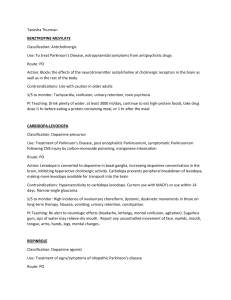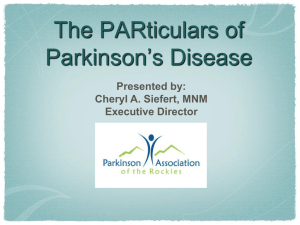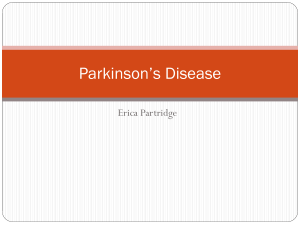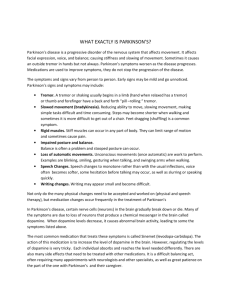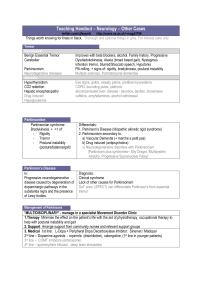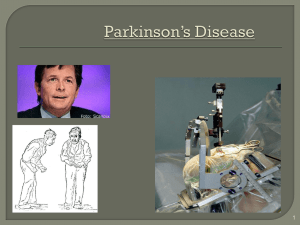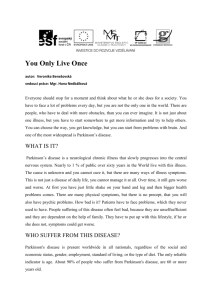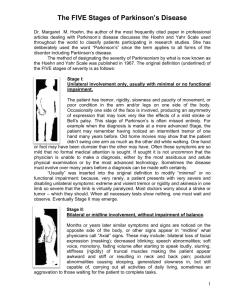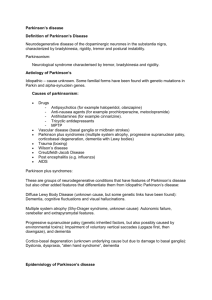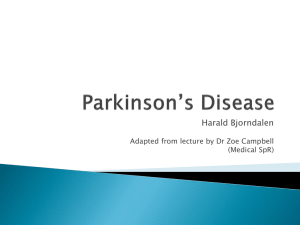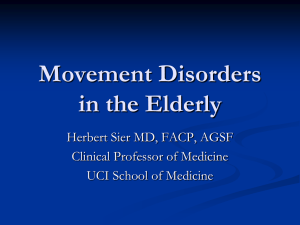parkinson's disease - University of Warwick
advertisement
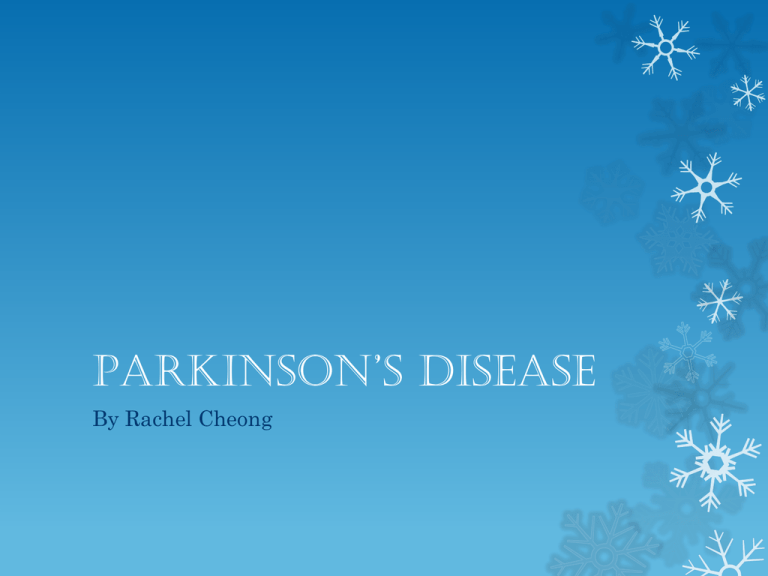
PARKINSON’S DISEASE By Rachel Cheong WHAT IS PARKINSON’S DISEASE? REfERS tO IDIOPAthIc/ PRImARy PARKINSON’S DISEASE Parkinsonism of unknown aetiology Parkinsinonism= tremor at rest, stiffness, slowing of movement and postural instability. Part of the Movement Disorders known as Akinetic-Rigid syndromes Akinetic-Rigid Syndromes= slowed movement, increased tone Dyskinesias= added, uncontrollable movements Definition: Degenerative, progressive disease Akinetic-Rigid Syndromes Dyskinesias Idiopathic Parkinson’s Disease Essential tremor Drug-induced Parkinsonism Chorea MPTP-induced Parkinsonism Hemiballismus Postencephalitic Parkinsonism Myoclonus Parkinsonism-plus Tics Wilson’s Disease Dystonias Childhood akinetic-rigid syndromes Paroxysmal dyskinesias IDIOPAthIc PARKINSON’S DISEASE Described in 1817 by James Parkinson- “thE ShAKINg PAlSy” Prevalence: 65.6 per 100,000 to 125 per 100,000. UK Incidence= approx. 128,000 cases Incidence increases severely with age: from 17.4 in 100,000 person years between 50 and 59 years of age to 93.1 in 100,000 person years between 70 and 79 years Slightly more common in men Insidious onset and progression Studies suggest patients born in the spring have a higher incidence of PD Characterized by accumulation of alpha- Related factors: Nicotine: inverse relationship as acts like MAOB inhibitors and stimulates dopamine Caffeine may be protective MPTP: methylphenyltetrahydropyridine (illicit stimulant/herbicides) causes severe parkinsonism Encephalitis Lethargica: parkinsonism postencephalitis Genetics: (a) Familial clusters of early-onset PD (b) Mutations on Parkin gene on Chr 6 (under 40s; AR) (c) α-synuclein gene mutation on Chr 2p13 (d) Ubiquitin carboxyl terminal hydrolase L1 (UCHL1) gene on Chr 4p14-16.3 Neuroanatomy Basal Ganglia =A large group of nuclei deep within the brain that affects movement. =Include the caudate nucleus & putamen (striatum), globus pallidus, subthalamic nucleus, and substantia nigra Substantia Nigra = Generates dopamine which regulates reward and movement. PATHOPHYSIOLOGY •The basal ganglia and the cerebellum transmit information via the thalamus to the cerebral cortex to regulate movement. •In a healthy brain, the neurons in the substantia nigra release dopamine into the striatum modulates neuronal activity affects movements + behaviours. • In Parkinson's disease, there is a breakdown in the connection between the striatum (neuron cells die/become impaired) decreased dopamine levels • Symptoms of Parkinson's disease appear after: •60% - 80% of the neuronal cells become impaired or die. •Striatal dopamine levels have decreased by 20% - 50% of normal levels SIGNS & SYMPTOMS 1. Tremor- 4-7Hz pill-rolling tremor at rest (decreases with action) 2. Rigidity- lead-pipe/plastic rigidity, more marked on one side; Cogwheeling when occurs with tremor. 3. Akinesia/ Bradykinesia- poverty/slowing of movement; difficulty initiating movement; loss of fine-finger movements; micrographia; mask-like facial expression; serpentine stare (decreased blinking) 4. Postural/Gait Change- Stooping (Simian); festinant/shuffling gait with poor arm swing; balance deterioratesfalls 5. Monotonous, tremulous speech slurring dysarthria anarthria 6. Cognitive decline 7. Depression, Apathy, Anxiety DIAGNOSIS o Clinical diagnosis o NICE recommends using the UK Parkinson's Disease Society (PDS) Brain Bank Criteria for diagnosis: • Step 1: diagnosis of Parkinsonian syndrome BRADyKINESIA + ≥ 1 Of : Muscular rigidity. 4- to 6-Hz resting tremor. Postural instability not caused by primary visual, vestibular, cerebellar or proprioceptive dysfunction. • Step 2: exclusion criteria for Parkinson's disease: History of CVA/ step-wise progression/ head trauma/ / autonomic+cerebellar Sx/ Exposure to known drugs/ Negative response to Dopa trial/ Early severe dementia Step 3: supportive prospective positive criteria of Parkinson's disease Three or more are required for the diagnosis of definite PD: Unilateral onset. Rest tremor present. Progressive disorder. Persistent asymmetry affecting the side of onset most. Excellent response (70-100%) to L-dopa. Severe L-dopa-induced chorea. L-dopa response for five years or more. Clinical course of ten years or more. Hyposmia. Visual hallucinations. Investigations To exclude other causes CT/MRI: Exclude supratentorial tumours, normal pressure hydrocephalus and extensive subcortical vascular pathology. Positron emission tomography (PET) scanning: with fluorodopa to localise dopamine deficiency in the basal ganglia Transcranial sonography: differentiate PD from atypical or secondary Parkinsonian disorders, for early diagnosis of PD and for detection of subjects at risk for PD. Genetic testing- eg, Huntington's gene, singlegene mutations in familial PD Olfactory testing: differentiate PD from other Parkinsonian disorders For young-onset or atypical disease: measurement of ceruloplasmin levels (Wilson's Management NICE suggests specialist review every 6-12 months for clinical monitoring and medication adjustment Multidisciplinary management including specialist nurses, OT, physiotherapy, SALT, psychologists, social services Pharmacological Treatment: Levodopa Dopamine agonists MAO-BIs COMT inhibitors Amantadine Apomorphine Antimuscarinic drugs Surgical Treatment Palliative Care Levodopa Most effective/ most responsive Given with a peripheral dopa-decarboxylase inhibitor, which prevents peripheral conversion to dopamine Eg: Sinemet, Madopar Use lowest effective dose, eg: Sinemet 62.5 mg TDS increased to 125 mg after two weeks Adverse effects rare/mild: nausea, dizziness, weight loss Dopamine agonists Treats motor features Used in early disease, younger patients Can be adjuvant to Levodopa More severe/common adverse effects than Levodopa Non-ergot derivatives preferred, eg: pramipexole MAO-B Inhibitors Eg: Selegiline, Rasagiline Early treatment with selegiline alone can delay the need for levodopa therapy Addition of selegiline to a levodopa/decarboxylase inhibitor combination is more effective when introduced at 5 years from onset COMT Inhibitors Eg: Entacapone, Tolcapone Reversibly inhibit the peripheral breakdown of levodopa by the COMT enzyme Increases the amount available for conversion to dopamine in the brain and reducing fluctuations in plasma levels. Benefits patients with levodopa motor fluctuations Antimuscarinic drugs Eg: orphenadrine, procyclidine and trihexyphenidyl Improves motor function but common neuropsychiatric and cognitive S/E Reduces drug-induced Parkinsonism Amantadine monotherapy in early PD (for tremor or bradykinesia) weak and short-lived benefit; used as adjuvant later Apomorphine Given subcutaneously Used as a rescue agent in advanced disease to provide rapid but short-lived benefit for sudden, severe 'off' episodes use intermittent injections to reduce 'off time' and continuous infusion to reduce 'off time' and dyskinesias Surgical Treatment Developed in the mid-twentieth century before the advent of effective medical therapy. Recently enjoyed a resurgence Pallidotomy Subthalamic Surgery Thalamic Surgery Deep Brain Stimulation Complications “WEARINg Off PhENOmENON” OR “ON-Off fluctuAtIONS” Dyskinesias Depression & Anxiety Hallucinations & Psychosis Dementia Compulsive Behaviours Parkinsonian Crisis -Acute akinesia -rare but life-threatening complication -sudden worsening of motor symptoms and severe akinesia. -Triggers include infections, surgery, gastrointestinal disease and changes in medication. -Acute akinesia is difficult to treat and often needs Parkinson’s Plus Syndrome Multiple System Atrophy -Shy-Drager Syndrome -autonomic dysfunction, parkinsonism, ataxia Progressive Supranuclear Palsy -Steele-Richardson-Olszewski syndrome -Supranuclear ophthalmoplegia, neck dystonia, Parkinsonism, Pseudobulbar palsy, behavioral and cognitive impairment, imbalance and difficulties walking, frequent falls Corticobasal Degeneration -Parkinsonism, Alien Hand Syndrome, Apraxia, Aphasia Pick’s Disease -frontotemporal dementia, progressive nonfluent Case Scenario A 64 year old man attends his GP after his wife made him come. For the last 6 months he has noticed that he is slowing down. It takes him a long time to do simple tasks like getting dressed. His hands are shaking all the time, more so on the right. His wife has noticed a change in his gait saying he shuffles when he walks. He has no past medical history of notes and is on no regular medication and has no known allergies. On examination he has a blank staring expression and marked rigidity of his limbs, more so on the right. He has resting pill rolling tremor. His gait is shuffling and festinant What is your differential diagnosis? References NICE Guidelines http://www.nice.org.uk/nicemedia/live/10984/30088/ 30088.pdf University of Minnesota- Neurology Teaching Webpage Kumar & Clark Pg. 1144-1147 Oxford Handbook Pg. 368-369, 534 Patient Plus Reference http://www.patient.co.uk/doctor/parkinsonsdisease-management INtERNAtIONAl PARKINSON’S AND mOvEmENt Disorders Society http://www.movementdisorders.org/disorders/par kinson.php
